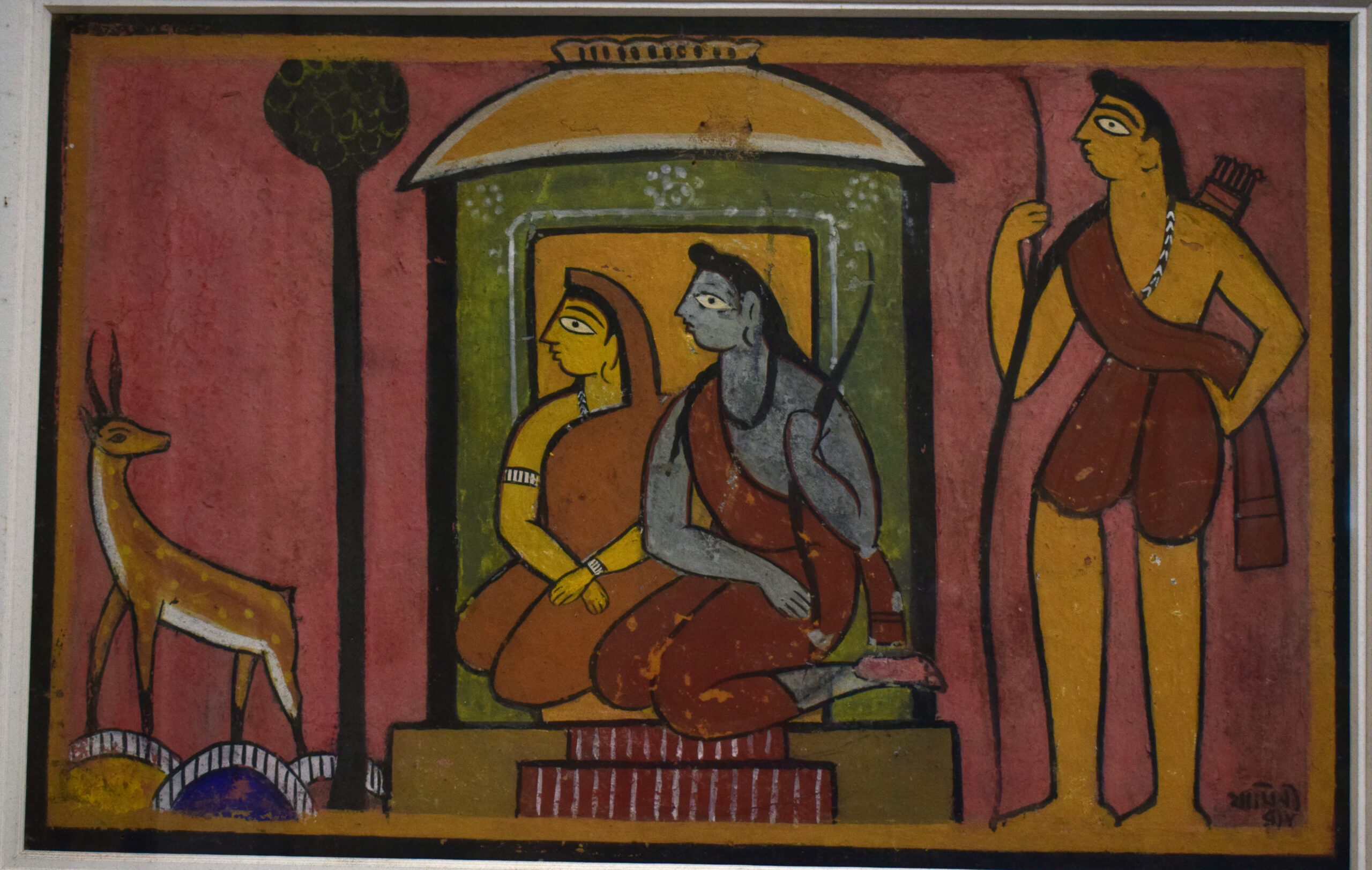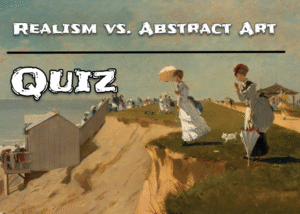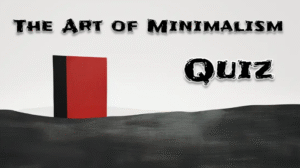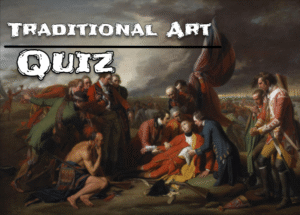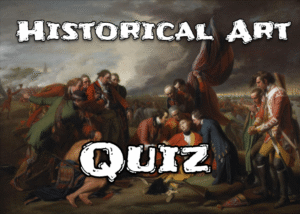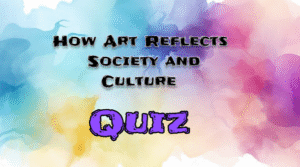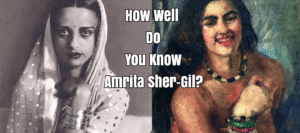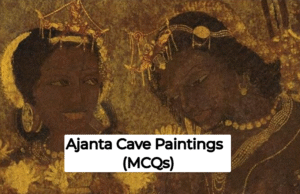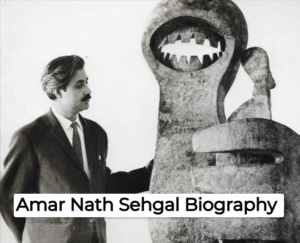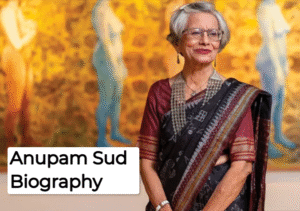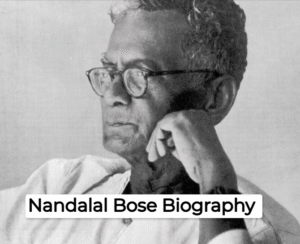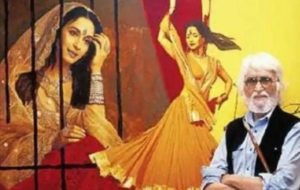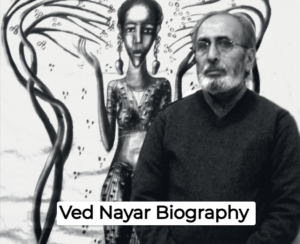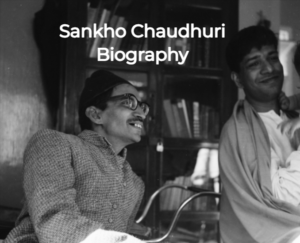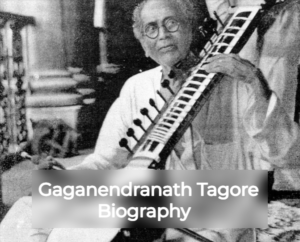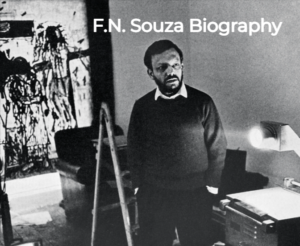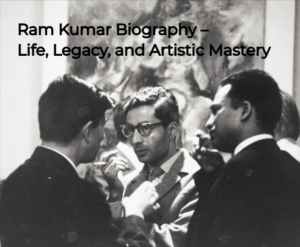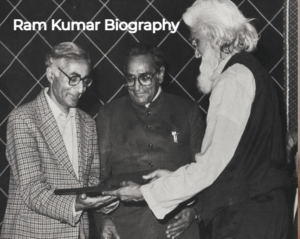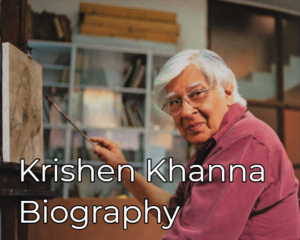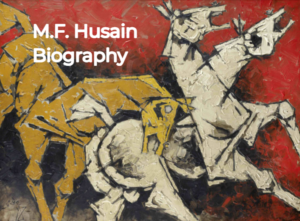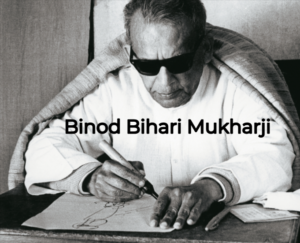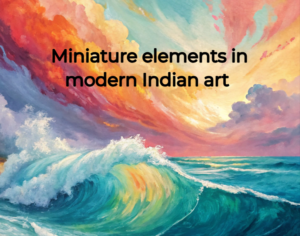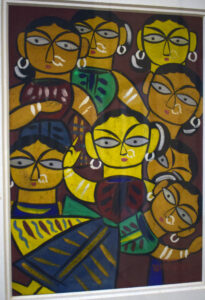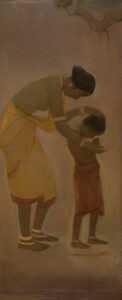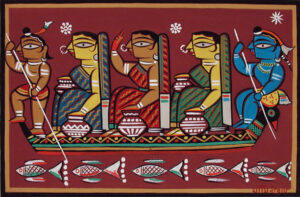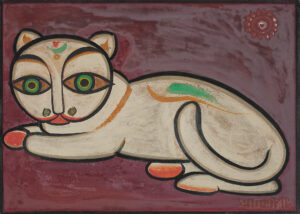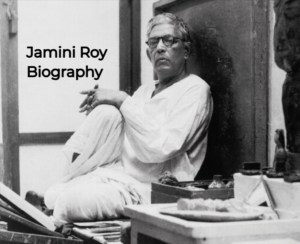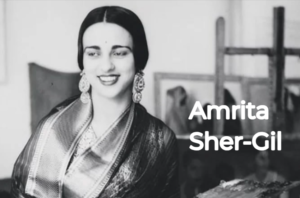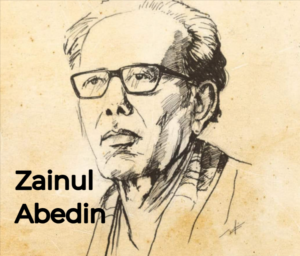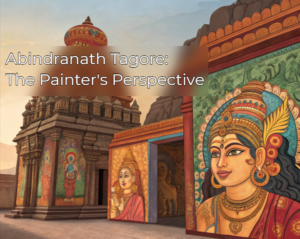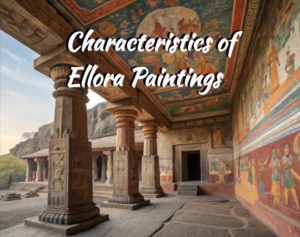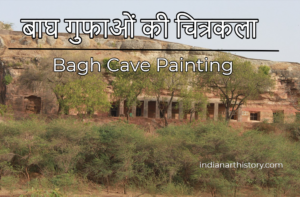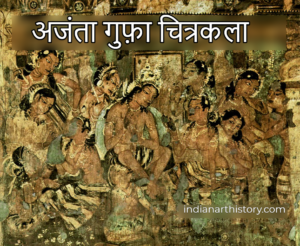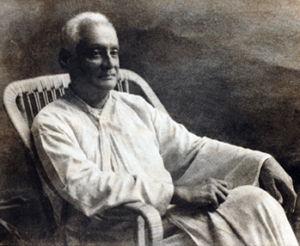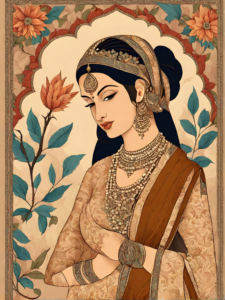Jamini Roy (1887–1972) was a pioneering modern Indian artist known for his rejection of Western academic painting in favor of Indian folk traditions. His art remains one of the most influential movements in Indian modern art.
Table of Contents
1. Life and Early Career
- Born: April 11, 1887, in Beliatore, Bengal, India.
- Education: Studied at the Government College of Art & Craft, Kolkata (1903–1908), where he was trained in Western academic realism.
- Early Style: Initially painted in the Western academic style, including landscapes and portraits.
- Shift to Indian Folk Art: By the 1920s, Roy abandoned European techniques and embraced Bengali folk art, Kalighat paintings, and Indian mythology.

2. Artistic Style and Techniques
A. Inspiration from Folk Art
- Roy was inspired by Kalighat paintings, Bengali scroll paintings (Patachitra), and Ajanta murals.
- His works often depicted Hindu deities, village life, tribal figures, and mother-child themes.
B. Key Features of His Art
- Bold Black Outlines: Thick black lines define figures, similar to Kalighat art.
- Flat, Two-Dimensional Figures: No shading or depth, making his art simple but powerful.
- Limited Color Palette: Used red, yellow, ochre, blue, green, white, and black made from natural pigments.
- Traditional Materials: Painted on cloth, board, and handmade paper instead of canvas.
3. Notable Paintings by Jamini Roy
| Painting Name | Year | Theme |
|---|---|---|
| Bride and Two Companions | 1940s | Folk and rural life |
| Cats Sharing a Prawn | 1940s | Animal symbolism |
| Mother and Child | 1940s | Maternal love |
| Three Pujarinis | 1950s | Bengali temple women |
| Krishna and Balarama | 1940s | Hindu mythology |
| Gopini | 1940s | Women in rural Bengal |
| Radha and Krishna | 1950s | Devotional art |
| Ramayana Series | 1940s | Hindu epic scenes |
4. Awards and Recognition
- Padma Bhushan (1954): Awarded by the Government of India for his contributions to Indian art.
- First Indian Artist to Achieve Mass Popularity: His artworks were affordable and widely available.
- International Fame: His paintings are displayed in major museums, including the National Gallery of Modern Art (NGMA), New Delhi, and Victoria and Albert Museum, London.
5. Legacy and Influence
- Revived Indian Folk Art: Roy helped make folk art a respected form of modern Indian painting.
- Inspired Future Generations: His work influenced artists like S. H. Raza, M. F. Husain, and Tyeb Mehta.
- Affordable Art Movement: He made art accessible beyond the elite, influencing how art is perceived in India.
- Modern Interpretations: Today, his style continues to inspire graphic designers, illustrators, and contemporary artists.
Conclusion
Jamini Roy’s contribution to Indian art is unparalleled. His rejection of Western styles and embrace of Indian folk traditions made his work a symbol of national pride. His paintings, known for their bold lines, vibrant colors, and cultural depth, continue to be celebrated worldwide.
Read More:
- Realism vs. Abstract Art | Quiz
 Realism vs. Abstract Art Quiz Restart Quiz let currentQuestion = 0; let score = 0; …
Realism vs. Abstract Art Quiz Restart Quiz let currentQuestion = 0; let score = 0; … - The Art of Minimalism | Quiz
 The Art of Minimalism Quiz Restart Quiz let currentQuestion = 0; let score = 0; …
The Art of Minimalism Quiz Restart Quiz let currentQuestion = 0; let score = 0; … - Traditional Art Quiz
 Traditional Art Quiz Restart Quiz let currentQuestion = 0; let score = 0; const quizContainer …
Traditional Art Quiz Restart Quiz let currentQuestion = 0; let score = 0; const quizContainer … - Historical Art Quiz
 Historical Art Quiz Restart Quiz let currentQuestion = 0; let score = 0; const quizContainer …
Historical Art Quiz Restart Quiz let currentQuestion = 0; let score = 0; const quizContainer … - How Art Reflects Society and Culture Quiz
 How Art Reflects Society and Culture Quiz Restart Quiz let currentQuestion = 0; let score …
How Art Reflects Society and Culture Quiz Restart Quiz let currentQuestion = 0; let score … - The Role of Art in Mental Health and Therapy Quiz
 The Role of Art in Mental Health and Therapy Quiz Restart Quiz let currentQuestion = …
The Role of Art in Mental Health and Therapy Quiz Restart Quiz let currentQuestion = … - Gaming Characters Quiz
 Gaming Characters Quiz Restart Quiz let currentQuestion = 0; let score = 0; const quizContainer …
Gaming Characters Quiz Restart Quiz let currentQuestion = 0; let score = 0; const quizContainer … - Blox Fruits Quiz
 Blox Fruits Quiz Restart Quiz let currentQuestion = 0; let score = 0; const quizContainer …
Blox Fruits Quiz Restart Quiz let currentQuestion = 0; let score = 0; const quizContainer … - Solo Leveling Quiz
 Solo Leveling Quiz Restart Quiz let currentQuestion = 0; let score = 0; const quizContainer …
Solo Leveling Quiz Restart Quiz let currentQuestion = 0; let score = 0; const quizContainer … - How Well Do You Know Dragon Ball Z | Quiz
 Dragon Ball Z Quiz Restart Quiz let currentQuestion = 0; let score = 0; const …
Dragon Ball Z Quiz Restart Quiz let currentQuestion = 0; let score = 0; const … - Attack On Titan Quiz
 Attack on Titan Quiz Restart Quiz let currentQuestion = 0; let score = 0; const …
Attack on Titan Quiz Restart Quiz let currentQuestion = 0; let score = 0; const … - How Well Do You Know Naruto Uzumaki
 Naruto Quiz Restart Quiz let currentQuestion = 0; let score = 0; const quizContainer = …
Naruto Quiz Restart Quiz let currentQuestion = 0; let score = 0; const quizContainer = … - One Piece Quiz
 One Piece Quiz Restart Quiz let currentQuestion = 0; let score = 0; const quizContainer …
One Piece Quiz Restart Quiz let currentQuestion = 0; let score = 0; const quizContainer … - How Well Do You Know Amrita Sher-Gil?
 Question 1 Amrita Sher-Gil is known as:A) The Queen of Mughal ArtB) The Pioneer of …
Question 1 Amrita Sher-Gil is known as:A) The Queen of Mughal ArtB) The Pioneer of … - GK Quiz
 Modern Art Quiz Restart Quiz // Additional 15 questions on Modern Art { question: “Who …
Modern Art Quiz Restart Quiz // Additional 15 questions on Modern Art { question: “Who … - How Well Do You Know Amrita Sher-Gil?
 Quiz: How Well Do You Know Amrita Sher-Gil? Start Quiz Next Your Score: /20 Restart …
Quiz: How Well Do You Know Amrita Sher-Gil? Start Quiz Next Your Score: /20 Restart … - Blox Fruits Quiz
 Blox Fruits Quiz NEXT RESTART QUIZ let currentQuestion = 0; let score = 0; const …
Blox Fruits Quiz NEXT RESTART QUIZ let currentQuestion = 0; let score = 0; const … - Mine Craft Quiz
 Minecraft Quiz NEXT RESTART QUIZ NEXT: Mine Craft Quiz Can You Name These Iconic Actors?
Minecraft Quiz NEXT RESTART QUIZ NEXT: Mine Craft Quiz Can You Name These Iconic Actors? - Ajanta Cave Paintings (MCQs)
 100 multiple choice questions (MCQs) about Ajanta Cave Paintings, divided into categories 🏛️ General Information 🕰️ Historical Context 🖌️ Art …
100 multiple choice questions (MCQs) about Ajanta Cave Paintings, divided into categories 🏛️ General Information 🕰️ Historical Context 🖌️ Art … - Amar Nath Sehgal Biography, Childhood, Life, Artworks, Media, Awards, Exhibitions, Career + Legacy Guide + Top 15 Insights
 Amar Nath Sehgal (b. 1922) A philosopher, poet, artist and craftsman, Amar Nath Sehgal’s unique …
Amar Nath Sehgal (b. 1922) A philosopher, poet, artist and craftsman, Amar Nath Sehgal’s unique … - Anupam Sud’s Contribution to Women in Art
 Anupam Sud holds a unique and powerful place in the history of Indian art, particularly …
Anupam Sud holds a unique and powerful place in the history of Indian art, particularly … - Anupam Sud Biography: Untold Legacy & 15 Insightful Facts About the Iconic Printmaker
 Anupam Sud Biography explores the life, legacy, and powerful impact of one of India’s most …
Anupam Sud Biography explores the life, legacy, and powerful impact of one of India’s most … - Nandalal Bose Biography | Life, Paintings
 Nandalal Bose (1882-1966) Even as a young student at the Khudiram Bose’s Central Collegiate School, …
Nandalal Bose (1882-1966) Even as a young student at the Khudiram Bose’s Central Collegiate School, … - Anupam Sud Biography | Life, artworks
 Anupam Sud (b.1944) Anupam Sud, an outstanding graphist, has adopted printmaking, not only for artistic …
Anupam Sud (b.1944) Anupam Sud, an outstanding graphist, has adopted printmaking, not only for artistic … - Location Tracker App: Just Enter a Mobile Number and See Anyone’s Live Location—Right on Your Phone!
 Learn how to use Google Maps as a free Location Tracker App—no subscription, zero cost, …
Learn how to use Google Maps as a free Location Tracker App—no subscription, zero cost, … - MF Hussain Painting and Madhuri Dixit: A Captivating Fusion of Art and Bollywood
 Explore the iconic MF Hussain paintings of Madhuri Dixit and the deep artistic connection between …
Explore the iconic MF Hussain paintings of Madhuri Dixit and the deep artistic connection between … - Ved Nayar Biography | Life, artworks
 Ved Nayar (b.1933) With the spread of installation art in the 1990s, there has been …
Ved Nayar (b.1933) With the spread of installation art in the 1990s, there has been … - Sankho Chaudhuri Biography | Life Artworks
 Sankho Chaudhuri (b.1916) Sankho Chaudhuri is n product Of a period in our history in …
Sankho Chaudhuri (b.1916) Sankho Chaudhuri is n product Of a period in our history in … - Gaganendranath Tagore Biography | Life, Paintings
 Gaganendranath Tagore (1867-1938) Gaganendranath Tagore, eldest brother of Abanindranath Tagore, was only seventeen years of …
Gaganendranath Tagore (1867-1938) Gaganendranath Tagore, eldest brother of Abanindranath Tagore, was only seventeen years of … - F.N. Souza Biography: Life, Art, and Legacy of a Modernist Rebel
 Introduction Ever heard of an artist who painted saints and sinners with the same passion? …
Introduction Ever heard of an artist who painted saints and sinners with the same passion? … - F.N. Souza Biography | Life, Artworks
 F.N. Souza has produced an imaginative body of figurative paintings that are independent of any …
F.N. Souza has produced an imaginative body of figurative paintings that are independent of any … - Pran Nath Mago Biography
 A painter, designer, art educationist, and art critic, Mago retired as a professor in fine …
A painter, designer, art educationist, and art critic, Mago retired as a professor in fine … - What is the art style of Ram Kumar?
 Ram Kumar (1924–2018) was a prominent Indian artist whose work evolved significantly over his career, …
Ram Kumar (1924–2018) was a prominent Indian artist whose work evolved significantly over his career, … - Ram Kumar Biography – Life, Legacy, and Artistic Mastery
 Introduction to Ram Kumar: The Visionary Indian Artist Ram Kumar stands as a towering figure …
Introduction to Ram Kumar: The Visionary Indian Artist Ram Kumar stands as a towering figure … - Ram Kumar
 Ram Kumar, an important landscape painter, studied under Andre Lhote and Fernand Leger, and has …
Ram Kumar, an important landscape painter, studied under Andre Lhote and Fernand Leger, and has … - Tyeb Mehta
 Tyeb Mehta Biography: Untold Journey of India’s Modern Art Pioneer Introduction to Tyeb Mehta The …
Tyeb Mehta Biography: Untold Journey of India’s Modern Art Pioneer Introduction to Tyeb Mehta The … - Krishen Khanna Biography
 Krishen Khanna is known for his figurative approach. His later paintings around (1990) are revolutionary …
Krishen Khanna is known for his figurative approach. His later paintings around (1990) are revolutionary … - Art — An Introduction
 What is Art — An Introduction (Indian Context) Art is a technique to complete work …
What is Art — An Introduction (Indian Context) Art is a technique to complete work … - M.F. Husain Biography | Controversy, Paintings
 M.F. Husain 1915-2010 M. F. Husain has become the symbol of modern Indian art with …
M.F. Husain 1915-2010 M. F. Husain has become the symbol of modern Indian art with … - Binod Bihari Mukharji
 Binod Bihari, who also had literary interests possessed an intellectual curiosity that led to an analytical …
Binod Bihari, who also had literary interests possessed an intellectual curiosity that led to an analytical … - K. G. Subramanyan Biography
 K.G. Subramanyan, a prolific contemporary artist, was a painter, a muralist, designer, printmaker, toymaker, weaver and also …
K.G. Subramanyan, a prolific contemporary artist, was a painter, a muralist, designer, printmaker, toymaker, weaver and also … - Raja Ravi Varma: A Master of Indian Art and His Lasting Legacy
 Introduction Raja Ravi Varma is one of India’s most celebrated painters, known for his fusion …
Introduction Raja Ravi Varma is one of India’s most celebrated painters, known for his fusion … - Miniature elements in modern Indian art
 Miniature is a beautiful step of medieval Indian painting. The paintings that started first on …
Miniature is a beautiful step of medieval Indian painting. The paintings that started first on … - Architectural Backgrounds in Indian Miniature Art Style
 Explore the beauty of architectural backgrounds in Indian miniature art style, their historical significance, techniques, …
Explore the beauty of architectural backgrounds in Indian miniature art style, their historical significance, techniques, … - Jamini Roy’s Artistic Techniques and Influences
 Jamini Roy (1887–1972) is one of India’s most celebrated modern artists. His work was deeply …
Jamini Roy (1887–1972) is one of India’s most celebrated modern artists. His work was deeply … - Jamini Roy: Life, Legacy, and Notable Works
 Jamini Roy (1887–1972) was a pioneering modern Indian artist known for his rejection of Western …
Jamini Roy (1887–1972) was a pioneering modern Indian artist known for his rejection of Western … - Jamini Roy: Personal Influences, Artistic Journey, and Exhibitions
 Jamini Roy (1887–1972) was a revolutionary Indian artist who redefined modern Indian art by embracing …
Jamini Roy (1887–1972) was a revolutionary Indian artist who redefined modern Indian art by embracing … - Jamini Roy’s Painting Techniques and the Value of His Art Today
 Jamini Roy (1887–1972) revolutionized modern Indian art by incorporating folk traditions, bold colors, and simplified …
Jamini Roy (1887–1972) revolutionized modern Indian art by incorporating folk traditions, bold colors, and simplified … - Jamini Roy’s Influence on Modern Indian Art and Notable Paintings
 Jamini Roy (1887–1972) is one of the most influential figures in modern Indian art. His …
Jamini Roy (1887–1972) is one of the most influential figures in modern Indian art. His … - How to Identify an Original Jamini Roy Painting
 Jamini Roy’s paintings are highly valuable, and many forgeries exist in the market. If you’re …
Jamini Roy’s paintings are highly valuable, and many forgeries exist in the market. If you’re … - Jamini Roy’s Influence on Modern Art Movements and a Detailed Look at His Iconic Paintings
 Jamini Roy (1887–1972) was a revolutionary artist who transformed Indian modern art by embracing folk …
Jamini Roy (1887–1972) was a revolutionary artist who transformed Indian modern art by embracing folk … - Jamini Roy Biography | Life and Paintings
 Jamini Roy (1887-1972) As early as the 1930s, Jamini Roy had anticipated the current vogue …
Jamini Roy (1887-1972) As early as the 1930s, Jamini Roy had anticipated the current vogue … - Jamini Roy’s Notable Paintings and Artistic Techniques
 Jamini Roy (1887–1972) is known for his bold, simplified figures, strong black outlines, and earthy …
Jamini Roy (1887–1972) is known for his bold, simplified figures, strong black outlines, and earthy … - Amrita Sher-Gil | Biography | Life | Paintings
 Amrita Sher-Gil (1913-41) Amrita Sher-Gil was born of a Hungarian mother and a Sikh father. Amrita …
Amrita Sher-Gil (1913-41) Amrita Sher-Gil was born of a Hungarian mother and a Sikh father. Amrita … - A R Chughtai | Biography | Life | Paintings
 A R Chughtai (1899-1975) The last artist of the Chughtai family, Mohd. Abdul Rehman Chughtai, …
A R Chughtai (1899-1975) The last artist of the Chughtai family, Mohd. Abdul Rehman Chughtai, … - Zainul Abedin Biography | Life, Paintings
 Zainul Abedin (1917-1976) According to Nazrul Islam, the great revolutionary poet of Bengal, the significance …
Zainul Abedin (1917-1976) According to Nazrul Islam, the great revolutionary poet of Bengal, the significance … - What is Kate Moss’s Net Worth? Everything You Need to Know About the Supermodel’s Wealth
 What is Kate Moss’s net worth? Discover everything about the supermodel’s financial empire, income sources, …
What is Kate Moss’s net worth? Discover everything about the supermodel’s financial empire, income sources, … - World’s Most Beautiful Women
 Beauty, an intricate tapestry woven from physical allure, charisma, talent, and influence, transcends mere appearance. …
Beauty, an intricate tapestry woven from physical allure, charisma, talent, and influence, transcends mere appearance. … - Impressionism
 The first important movement of modern painting in Europe is Impressionism. It was mainly prevalent …
The first important movement of modern painting in Europe is Impressionism. It was mainly prevalent … - Abindranath Tagore: The Painter’s Perspective
 Abanindranath Tagore, a renowned artist and member of the prestigious Tagore family, left an indelible …
Abanindranath Tagore, a renowned artist and member of the prestigious Tagore family, left an indelible … - Characteristics of Ellora Paintings
 Ellora Paintings It is called Verulleni or Verul Caves in Marathi which is only 9 …
Ellora Paintings It is called Verulleni or Verul Caves in Marathi which is only 9 … - Steel Outdoor Furniture
 People like to use their backyard or patio as another room when it’s warm outside. …
People like to use their backyard or patio as another room when it’s warm outside. … - Aluminum or Steel: Which is Better For Outdoor Furniture
 Summer is almost here. As the sun shines bright and warm, many homeowners want outdoor …
Summer is almost here. As the sun shines bright and warm, many homeowners want outdoor … - Most Comfortable Outdoor Chair
 At times, sitting in a nice chair outdoors on a sunny day can be a …
At times, sitting in a nice chair outdoors on a sunny day can be a … - Types of Outdoor Furniture Material
 Are you wondering what are the types of outdoor furniture materials? If yes then you …
Are you wondering what are the types of outdoor furniture materials? If yes then you … - Best Fabric for Outdoor Furniture
 These days, folks are using outside spaces like patios as work spots. Due to quarantines, …
These days, folks are using outside spaces like patios as work spots. Due to quarantines, … - Powder Coated Steel Outdoor Furniture
 Do you want a fashionable and comfortable outdoor space that will last long? Are you …
Do you want a fashionable and comfortable outdoor space that will last long? Are you … - Steel Outdoor Patio Furniture
 The patio is truly something else. It is a fantastic space for lounging, eating in …
The patio is truly something else. It is a fantastic space for lounging, eating in … - Best Outdoor Furniture Material For Rain
 Are you looking for the best outdoor furniture material for rain? If yes then you …
Are you looking for the best outdoor furniture material for rain? If yes then you … - 12 Best Material For Outdoor Countertop
 Are you looking for the best material for outdoor countertops? If yes then you are …
Are you looking for the best material for outdoor countertops? If yes then you are … - Longest Lasting Outdoor Furniture Material
 Are you looking for the longest-lasting outdoor furniture material? If yes then you are at …
Are you looking for the longest-lasting outdoor furniture material? If yes then you are at … - What Is The Best Material for Patio Furniture?
 Are you looking for the best material for patio furniture? If yes then you are …
Are you looking for the best material for patio furniture? If yes then you are … - Best Material for Garden Furniture
 Are you looking for the best material for garden furniture? If yes then you are …
Are you looking for the best material for garden furniture? If yes then you are … - Most Durable Material For Outdoor Furniture
 Are you looking for the most durable material for outdoor furniture? If yes then please …
Are you looking for the most durable material for outdoor furniture? If yes then please … - How To Choose Best Material for Outdoor Furniture?
 Are you looking for the best material for outdoor furniture? If yes then you are …
Are you looking for the best material for outdoor furniture? If yes then you are … - the Basics of USA InsuranceLearn the basics of USA insurance, including types, benefits, and how it works. This guide …
- The Ultimate Guide to USA Insurance: Everything You Need to KnowLooking for comprehensive USA Insurance information? Friends, let’s talk about the different types of insurance, …
- The Ultimate Guide to USA Insurance: Everything You Need to KnowLooking for comprehensive USA Insurance information? Friends, let’s talk about the different types of insurance, …
- भारत में प्रसिद्ध बौद्ध तीर्थस्थल | Famous Buddhist Pilgrimage Sites in India
 बौद्ध तीर्थस्थल राज्य स्पितुक मठ, शे (Shey) मठ लद्दाख (जम्मू-कश्मीर) धनखड़ मठ, की (Key) मठ, …
बौद्ध तीर्थस्थल राज्य स्पितुक मठ, शे (Shey) मठ लद्दाख (जम्मू-कश्मीर) धनखड़ मठ, की (Key) मठ, … - बाघ गुफाओं की चित्रकला
 ये गुफाएँ मध्य प्रदेश में धार ज़िले की कुकशी तहसील में स्थित विंध्य पर्वत श्रेणी …
ये गुफाएँ मध्य प्रदेश में धार ज़िले की कुकशी तहसील में स्थित विंध्य पर्वत श्रेणी … - अजंता गुफ़ा चित्रकला
 अजंता चित्रकला महाराष्ट्र के औरंगाबाद ज़िले में सह्याद्रि की पहाड़ियों में स्थित अजंता में कुल …
अजंता चित्रकला महाराष्ट्र के औरंगाबाद ज़िले में सह्याद्रि की पहाड़ियों में स्थित अजंता में कुल … - गगनेन्द्रनाथ ठाकुर
 गगनेंद्रनाथ टैगोर को भारत का सबसे अधिक साहसी और आधुनिक चित्रकार माना गया। विनय कुमार सरकार ने उनका सम्बन्ध भविष्यवाद से जोड़ा। किन्तु वास्तव में गगनेन्द्रनाथ ठाकुर पूर्ण रूप से घनवादी अथवा भविष्यवादी चित्रकार नहीं हैं।
गगनेंद्रनाथ टैगोर को भारत का सबसे अधिक साहसी और आधुनिक चित्रकार माना गया। विनय कुमार सरकार ने उनका सम्बन्ध भविष्यवाद से जोड़ा। किन्तु वास्तव में गगनेन्द्रनाथ ठाकुर पूर्ण रूप से घनवादी अथवा भविष्यवादी चित्रकार नहीं हैं। - QUIZ: Can You Name These Iconic Actors?Start Quiz Archive Photos/Getty Images Are you an expert on Hollywood’s leading men? We’re going …
- Indian Woman Water Colour Painting FREE | Indian Woman Water Colour Digital Art Print FREE
 Download Water color Art For Free
Download Water color Art For Free - सुरिन्दर के० भारद्वाज | Surinder K. Bhardwajभारद्वाज का जन्म लाहौर में 20 अप्रैल 1938 को हुआ था। 1947 में भारत विभाजन …
- विवान सुन्दरम् | Vivan Sundaramविवानसुन्दरम् का जन्म शिमला में हुआ था। अमृता शेरगिल इनकी मौसी थीं जो इनके जन्म …
- रंगास्वामी सारंगन् | Rangaswamy Saranganरंगास्वामी सारंगन का जन्म 1929 में तंजौर में हुआ था। 1952 में उन्होंने मद्रास कला-विद्यालय …
- शान्ति दवे | Shanti Daveशान्ति दवे का जन्म अहमदाबाद में 1931 में हुआ था। वे बड़ौदा विश्वविद्यालय के 1956 …
- गुलाम रसूल सन्तोष | Ghulam Rasool Santoshगुलाम रसूल सन्तोष का जन्म श्रीनगर (कश्मीर) में 19 जून 1929 ई० को हुआ था। …
- मोहन सामन्त | Mohan Samantमोहन सामन्त का जन्म 1926 में बम्बई में हुआ था। उनके घर वाले उन्हें इन्जीनियर …
- निकोलस रोरिक | Nicholas Roerichसुदूर के देशों से आकर भारतीय प्रकृति, दर्शन और संस्कृति से प्रभावित होकर यहीं पर …
- जार्ज कीट | George Keetजार्ज कीट जन्म से सिंहली किन्तु सांस्कृतिक दृष्टि से भारतीय हैं । उनका जन्म श्रीलंका …
- भाऊ समर्थ | Bhau Samarthभाऊ समर्थ का जन्म महाराष्ट्र में भण्डारा जिले के लाखनी नामक ग्राम में 14 मार्च …
- रसिक डी० रावल | Rasik D. Rawalरसिक दुर्गाशंकर रावल का जन्म सौराष्ट्र में सारडोई में 21 अगस्त 1928 ई. को हुआ …
- जे. सुल्तान अली | J. Sultan Aliजे० सुल्तान अली का जन्म बम्बई में . 12 सितम्बर 1920 को हुआ था। उन्होंने …
- अ० अ० आलमेलकर | Abdul Rahim Appa Bhai Alamelkarअब्दुल रहीम अप्पा भाई आलमेलकर का जन्म अहमदाबाद में हुआ था। बचपन से ही उन्हें चित्रकला …
- माधव सातवलेकर | Madhav Satwalekarमाधव सातवलेकर का जन्म 1915 ई० में हुआ था पश्चिमी यथार्थवादी एकेडेमिक पद्धति को भारतीय …
- श्यावक्स चावड़ा | Shiavax Chavdaश्यावक्स चावड़ा का जन्म दक्षिणी गुजरात के नवसारी करने में 18 जून 1914 को गुजराती …
- कहिंगेरी कृष्ण हेब्बार | Katingeri Krishna Hebbarकृष्ण हेब्बार का जन्म दक्षिणी कन्नड के एक छोटे से सुन्दर गाँव कट्टिगेरी में 15 …
- देवकृष्ण जटाशंकर जोशी | Devkrishna Jatashankar Joshiश्री डी०जे० जोशी का जन्म 7 जुलाई 1911 ई० को महेश्वर में एक ब्राह्मण ज्योतिषी …

